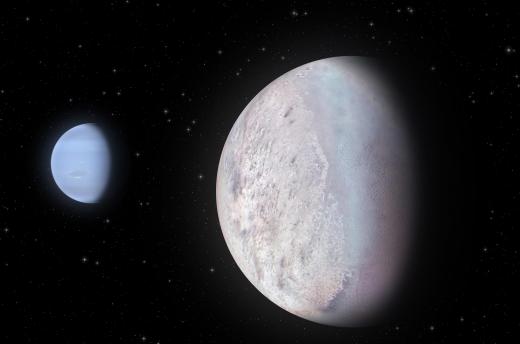What is Triton?
 Michael Anissimov
Michael Anissimov
Triton is the largest moon of the planet Neptune, with the distinction of having the coldest known surface in the solar system, at about 34.5 K. It is widely thought that Triton is a captured Kuiper belt object. The Kuiper belt is a second asteroid belt out beyond the orbit of Neptune. Pluto and Eris are examples of Kuiper belt objects.
On 25 August 1989, the Voyager 2 spacecraft made a fly-by of the Neptunian system and took high-resolution pictures of Triton. It is one of the most distant solar system bodies to be photographed at this resolution, and will remain so until the New Horizons spacecraft reaches Pluto in 2015. Triton will also be the only likely Kuiper belt object to be photographed at this resolution until 2015.

Triton is quite large — at 2700 km (1678 mi) diameter, it is about 78% the size of our Moon. It is considered one of the "big seven" satellites in the solar system, alongside Ganymede and other large satellites. Unique among large satellites, it has a retrograde orbit, meaning it orbits "the wrong way," very suggestive that it is a captured Kuiper belt object. Neptune has relatively few satellites compared to other gas giants, and it is thought that the capture of Triton may have sent the missing satellites into eccentric orbits that collided with Neptune or spiraled off beyond Neptune's gravity well.
Triton has a distinctive "cantaloupe terrain" surface composed of extremely cold, dirty ice. Triton is similar in size and composition to Pluto, with relatively light features and not too many obvious impact craters. Triton may have been formed very far from the Sun. Its surface has various ridges, created during alternating cycles of thawing and freezing. Triton probably experienced significant tidal heating in the past, as its eccentric orbit normalized.
Triton has polar ice caps. Its surface is so light that it reflects 60-95% of light that reaches it, in comparison to our Moon which only reflects 10% of light. If Triton were in our night sky instead of the Moon, nighttime would be more than ten times brighter than it is now!
AS FEATURED ON:
AS FEATURED ON:











Discuss this Article
Post your comments